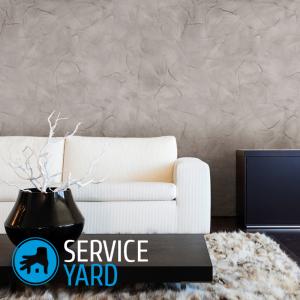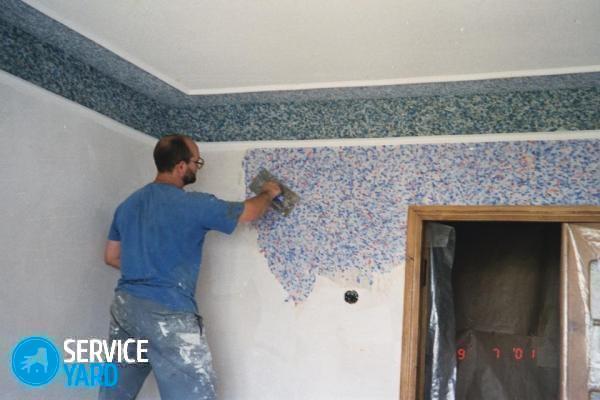Which is better - wallpaper or decorative plaster?

Repair is, of course, fascinating, but also extremely laborious. And to avoid such a process in the house, where they seek to create the most comfortable living conditions, is impossible. How often it will happen, of course, still depends on the preferences of a particular family. But any building materials have their own wear and tear, respectively - even if you are not at all inclined to change the interior often, you still have to gather all your will into a fist at least once every few years and start updating the decor. As soon as the repair plan begins to be drawn up, the question often arises: which is better - wallpaper or decorative plaster? There is no single answer. Each type of finish has its pros and cons. Consider them carefully.
to contents ↑Life time
Of no small importance is how durable this or that material. For example, plaster will serve a different time depending on its type:
- Mineral base - up to 30 years;
- Silicate or ceramic base - up to 50 years;
- Silicone base - up to 60 years.
Wallpaper, even the most expensive and high-quality, will last no more than 15 years. Accordingly - according to this criterion, the answer to the question which is better - wallpaper or decorative plaster is unambiguous.
to contents ↑Diversity
Another criterion for choosing a finishing material is, of course, its decorative capabilities. To decide whether a wallpaper or decorative plaster is better, let's look at the types of these 2 materials.
Types of decorative plaster
For the first time decorative plaster began to be applied in Italy. With its help, decoration was carried out in rich houses, murals were created, temples were decorated. The structure of the plaster may be different, it even imitates natural materials.
We will find out what types she has:
- Structural. The composition of this finished mixture includes a base and larger particles. Thanks to them, after applying the mixture, the surface is covered with grooves.
- Textured. It has a very great popularity. With its help, an imitation of natural stone is created on the surface. In addition, it is used to hide wall defects.
- Flock. The mixture is supplemented with additives that mimic silk. After using it, the room becomes more elegant.
- Venetian. Visually similar to marble, which makes the design of the room unique.
Types of Wallpaper
If you list the types of wallpaper, then they are much more, but they appeared earlier:
- Paper - are the most common. They are inexpensive, easy to stick. They can be water-repellent or paintable, but at the same time they are short-lived, are strongly worn out and burn out.
- Vinyls are the most versatile. They can be washed and cleaned, they are hygienic and wear-resistant, do not fade. Their thickness is large, so it is difficult to work with them. The only caveat - they do not “breathe” well, so they are not suitable for every room.
- For the manufacture of non-woven wallpaper, a non-woven fabric is used. They do not stretch and do not shrink. Such coatings are wear-resistant, well tolerate painting several times. Most importantly, they are breathable and hypoallergenic.
- Textile wallpapers look very expensive. The basis of them is made of paper or non-woven fabric; for lamination, natural fabric or threads are used, for the manufacture of which natural or mixed fibers are used.
Important! The main disadvantage is that the walls for gluing should be perfectly smooth, since all the flaws will be noticeable. And care for such material is more demanding.
- In the manufacture of velor wallpaper, nylon fibers are vertically applied to the paper base.This type of coating is very whimsical, strongly absorbs odors and attracts dust, so it is not very popular.
- For the manufacture of fiberglass wallpaper, quartz sand, soda, lime and dolomite are used. The surface thanks to them becomes smooth and structured. They help to cope with small cracks and flaws, very durable, withstand painting.
Important! The only drawback of such coatings, perhaps, is their high price.
- Liquid wallpaper consists of fibers of cotton, silk or cellulose. They are applied as paint or decorative plaster. Suitable for application on complex surfaces.
- Linkrust is a type of expensive finish. In them, a mixture of wood flour and mastics, lonoxin and chlorovinyl is applied to the paper base. The resulting mass is suitable for extruding a variety of patterns. For painting, oil paints and enamel are used.
- The jute wallpaper is also based on paper, and the second layer is represented by interwoven linen fibers.
Important! The main disadvantage is the high cost.
- Photowall-paper is presented by the whole or cut sheets of paper on which the photo image is applied. It can be glossy or matte. The top layer is a special film that is used for better preservation. Such material does not tolerate pollution and mechanical damage.
- Tufted - wallpapers are presented in the form of a fabric base on which a synthetic pile is sewn. They are characterized by fire resistance and immunity to moisture.
- The composition of metal wallpaper includes four layers: porous paper, thin aluminum foil, conductive paint and embossing. Often on such a coating there is a spraying of gold, silver or bronze.
- Cork oak bark is used to produce cork wallpapers. Such material can be used up to two decades, is environmentally friendly and has good thermal insulation performance.
 As you can see, if we take the design as the main criterion, definitely, better wallpaper, rather than plaster.
As you can see, if we take the design as the main criterion, definitely, better wallpaper, rather than plaster.
to contents ↑Important! Like it or not, and the wallpaper will not last as long as the same plaster. All the reasons are that this coating:
- It does not tolerate moisture. Holes in the wallpaper can appear even during gluing if too much glue is applied to them. This does not apply to all types of coatings, but still has a place to be.
- Severe if it is a washing wallpaper. In addition, the surface beneath them should be flat and machined.
- With a textile base it attracts dust too much.
- In case of violation of the technology of gluing, it can lead to the formation of mold.
Is it possible to save?
When the question arises: decorative plaster or wallpaper - what to choose, of course, the financial component is considered:
- In terms of price, a more profitable option is ordinary paper wallpaper. But it should be noted that in this case, it is necessary to prepare the walls. And this can cause significant additional costs.
- Non-woven or vinyl wallpapers are more expensive, but they do not need to perfectly align the wall, they can mask small defects.
- Liquid wallpaper looks great, but preparation before applying it should be very thorough. The walls are primed more than once, and then they are painted white.
- Decorative plaster is also different. And the higher its quality, the more expensive the cost per square meter. Plus, you need to add the cost of the coating work. As a result, a rather big amount. But you need to consider that this material is very durable.
Comparison of practicality and labor
For the final choice of material you need to consider how much labor costs:
- A couple of days will be enough to stick ordinary paper wallpaper. But if you take into account the time that will be spent on preparing the walls, then it will be spent about a week.
- But for the final drying of the decorative plaster it will take about two weeks.
In terms of practicality, a dispute, wallpaper or plaster - which is better, decorative plaster wins, of course:
- This material is more durable, easy to clean.
- If the wallpaper is damaged, it is not so easy to restore it, in the case of plaster everything is much simpler.
- And if there are small children in the house who like to paint on the walls? There are wax-based additives in the plaster, so you can wash everything off easily. It is even possible to use special detergents.
to contents ↑Important! But the minus is that the plaster can not be replaced too often, because such a procedure is quite expensive. It can only be repainted. Wallpaper in this case is a more winning option, which is chosen by those who like a frequent change of scenery.
Liquid Wallpaper - A Worthy Alternative to Stucco
In this material, wallpaper and stucco seem to be connected. The basis of this mixture is an adhesive base to which various fillers are added. It is difficult to determine whether liquid wallpaper or decorative plaster is better, because they contain cellulose, cotton and other natural fibers.
Important! To enrich the structure, it is possible to add threads of silk and wool, sequins, marble chips.
It is noteworthy that both of these materials are applied equally. To prepare the surface, it will take costs, but if there are minor irregularities - it's okay. The only difference with decorative plaster is practicality. Liquid wallpaper can not be washed, they are quickly damaged, do not tolerate dampness.
to contents ↑Important! In support of liquid wallpaper, it can be distinguished that when they are damaged, it is possible to quickly remove the damaged area and replace it.
Stock footage
So, before choosing a covering for the walls, you need to determine the overall design of the room and continue to adhere to its style. Otherwise, neither the wallpaper nor the decorative plaster will look. The view of the room should be harmonious.
- How to choose a vacuum cleaner taking into account the characteristics of the house and coatings?
- What to look for when choosing a water delivery
- How to quickly create comfort at home - tips for housewives
- How to choose the perfect TV - useful tips
- What to look for when choosing blinds
- What should be running shoes?
- What useful things can you buy in a hardware store
- Iphone 11 pro max review
- Than iPhone is better than Android smartphones



